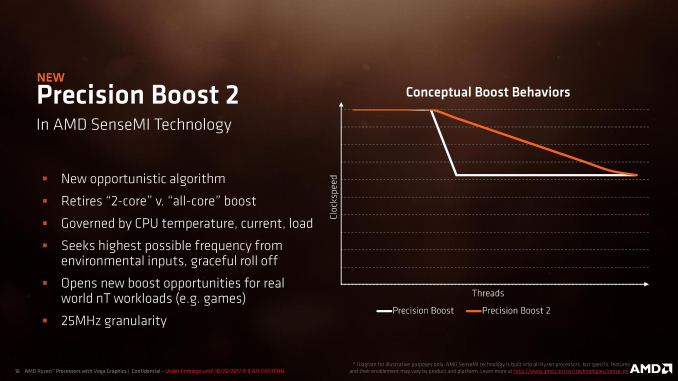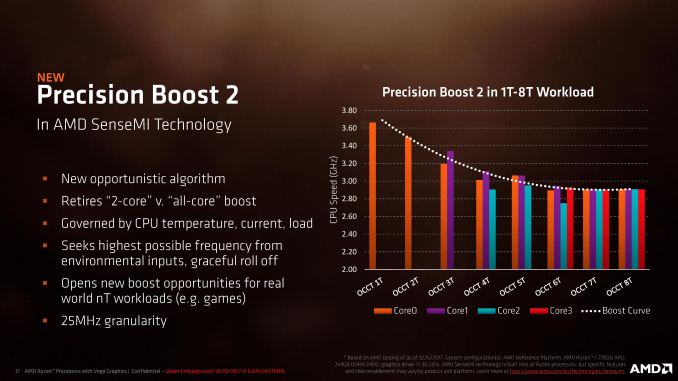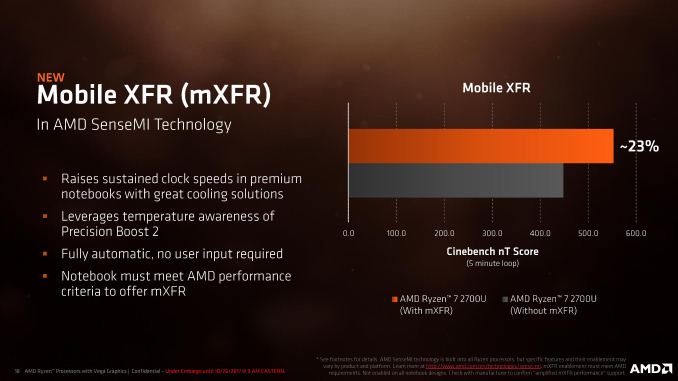Ryzen Mobile is Launched: AMD APUs for Laptops, with Vega and Updated Zen
by Ian Cutress on October 26, 2017 9:00 AM ESTSense Me Ryzen: Better Boost
When AMD launched the desktop Zen processors, it also branded a series of five technologies under the ‘SenseMI’ name. We covered these in detail in our Ryzen 7 review, but in short, it covers the following:
- Pure Power: Sensors to optimize power consumption
- Precision Boost: Determines how Turbo is applied
- Extreme Frequency Range: Going above maximum turbo when possible
- Neural Net Prediction: Using Neural Nets for prefetching data
- Smart Prefetch: Algorithms that work to enhance prefetch
With Ryzen Mobile, the features relating to frequency get an updated model, while Pure Power gets a bigger boost. We’ll cover the power changes on the next page, but it is worth talking about how AMD has improved Precision Boost and brought XFR to laptops.
Precision Boost 2
Most CPU turbo algorithms work by sensing how many cores and threads are under load, determining if the CPU has enough power headroom, and applying a voltage. This is why in the past both of the major x86 CPU manufacturers will quote a ‘per-core turbo frequency’ to show what the frequency should be when different numbers of cores are loaded and all else is fine (there is temperature/power headroom).
For Ryzen Mobile, AMD is pivoting to a new turbo model. When the system is in the P0 (top) turbo state, the system will use a new opportunistic turbo algorithm that rather than being based on the cores under load, is governed by CPU temperatures, currents, and how much load is being applied. The algorithm takes into account all the environmental inputs, such as skin temperature sensors and battery life, and will provide the best turbo frequency it can, regardless of if one thread is being used or all threads are being used.
It will be able to provide boost amounts at the 25 MHz granularity level, similar to how the desktop processors work, with the idea being that in most cases, if the system has a lot of cores available and a background process performs some very light work (such as checking for updates), rather than dropping 500-800 MHz because more cores are loaded, the system will keep at the high frequency.
AMD is stating that this has a big effect on real-world workloads, typically those that have variable thread workloads such as gaming.
When asked if Precision Boost 2 would be coming to the next generation of AMD’s Desktop Ryzen processors, I was told that ‘it could be inferred / it’s a safe bet’.
Mobile Extended Frequency Range (mXFR)
Because mobile systems are thermally limited, battery limited, power limited, and battery limited, offering ‘extra’ turbo headroom is not really something that processor manufacturers like to do. As a result, most of the Ryzen Mobile-powered notebooks will not have any form of XFR – AMD will be allowing it on a case-by-case basis for vendors that overengineer their chassis to be capable of supporting a higher power profile.
This feature essentially extends the average level at which Precision Boost 2 will operate, and also marks what could be considered a higher configurable TDP. One of the systems being launched with Ryzen Mobile this side of Christmas will be mXFR enabled, because the chassis is designed for 25W rather than 15W. It is worth noting that AMD states the configurable TDP of the Ryzen Mobile chips goes up to 25W, so this is likely the case what is happening.
Encode and Decode
AMD is fully using Vega’s encode and decode capabilities with Ryzen Mobile. The big inclusion for AMD’s mobile devices is the ability to decode VP9, the codec prefered in particular by YouTube.
| AMD Ryzen Mobile Encode/Decode Capabilities | |||||
| Decode 1080p @ 4:2:0 |
Decode 2160p @ 4:2:0 |
Encode 1080p |
Encode 1440p |
Encode 2160p |
|
| MPEG2 | 60 FPS | - | |||
| VC1 | 60 FPS | - | |||
| VP9 8/10 bpc | 240 FPS | 60 FPS | |||
| H.264 8 bpc | 240 FPS | 60 FPS | 120 FPS | 60 FPS | 30 FPS |
| H.264 10 bpc | 240 FPS | 60 FPS | |||
| HEVC 8bpc | 240 FPS | 60 FPS | 120 FPS | 60 FPS | 30 FPS |
| HEVC 10 bpc | 240 FPS | 60 FPS | |||
| JPEC 8bpc | 240 FPS | 60 FPS | |||













140 Comments
View All Comments
jjj - Thursday, October 26, 2017 - link
It's on 14nm,the actual silicon is maybe 15$ and then there is test and packaging.The cost of the die is not much of an issue.They can easily price the average SKU between 80-100$ with the fastest SKUs a bit above and the lesser SKUs bellow. Not that Intel has much different pricing, the prices they list have nothing to do with reality,.wumpus - Thursday, October 26, 2017 - link
While it likely costs the same to make as a R3 Ryzen (closer to an R7, because all CPU cores have to work), it will take a long time to dig themselves out of their hole by pricing it at $80-100.Don't forget they have to pay for the mask with "ryzen mobile" sales, while ryzen and epyc paid for Zepplin die tooling. I don't expect it to be a cheap chip unless AMD is absolutely forced to (like they have been forced to for years and are hungry for Intel level margins).
velanapontinha - Thursday, October 26, 2017 - link
A very small difference between both processors, yet one is Ryzen 5 and the other is Ryzen 7. I really hope these are the lowest R7 and the highest R5.zodiacfml - Friday, October 27, 2017 - link
Appears to me that these are the best parts already. I can get by with a mobile R3 without hyperthreading.stanleyipkiss - Thursday, October 26, 2017 - link
A 14" Acer Swift 3 with the Kaby Lake-R (4 core/8 thread) 8 GB RAM and a MX150 from nVidia gets better FPS in every game outlined by AMD here. Why go for this? It's not lighter, it's not more efficient, it's not faster.In the real world, GPU performance is sub-par a 1030 (MX150). The only upside is the fact that you don't have to deal with Intel's iGPU and nVidia's discrete GPU in the same package. Other than that... not worth the hassle.
BrokenCrayons - Thursday, October 26, 2017 - link
There appears to be a power advantage over a KB + MX150 since the combined consumption of the CPU and dGPU are higher than mobile Ryzen alone. All things equal, you're going to give up some GPU performance in exchange for more battery life. It's a trade-off some people will be willing to make and others will reject. Cool either way, just buy what works best for you and don't worry about it.With that said, I think Vega would do better with dedicated video memory of some sort which is why I would have liked to see these chips released with a small HBM cache that can be used to supplement the system's DDR4, but that's probably an unrealistic pipe dream for the time being. The added costs of associated would make mobile Ryzen more expensive...maybe more than a CPU + dGPU combination capable of the same performance.
Jon Tseng - Thursday, October 26, 2017 - link
Anyone got any hard numbs on how this compares to KBL + MX150? I saw some commentary that Ryzen Mobile was comparable to the 950M... IIRC MX150 was a perf bump on the old 940MX. So are they on a similar level or does MX150 have a material advantage?Was thinking that if they are in the same zip code perf wise then Ryzen is a no brainer given power draw..
stanleyipkiss - Thursday, October 26, 2017 - link
The MX150 is on par if not better than the old 960M. It's a huge step up from all iGPUs.BrokenCrayons - Thursday, October 26, 2017 - link
The 960M is consistently faster in synthetics (by a small margin) and in gaming benchmarks (by a much larger margin) than the MX150. Here's a couple of notebookcheck links to compare:https://www.notebookcheck.net/NVIDIA-GeForce-GTX-9...
https://www.notebookcheck.net/NVIDIA-GeForce-MX150...
vladx - Thursday, October 26, 2017 - link
Indeed GPU performance is vey dissapointing, but par for the course for Vega.